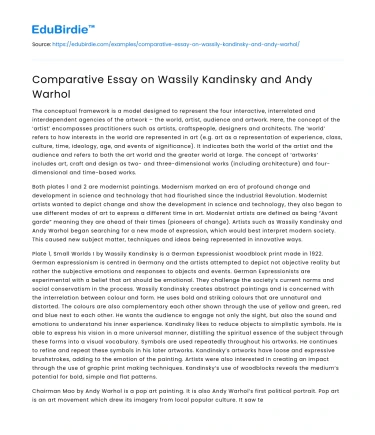The conceptual framework is a model designed to represent the four interactive, interrelated and interdependent agencies of the artwork – the world, artist, audience and artwork. Here, the concept of the ‘artist’ encompasses practitioners such as artists, craftspeople, designers and architects. The ‘world’ refers to how interests in the world are represented in art (e.g. art as a representation of experience, class, culture, time, ideology, age, and events of significance). It indicates both the world of the artist and the audience and refers to both the art world and the greater world at large. The concept of ‘artworks’ includes art, craft and design as two- and three-dimensional works (including architecture) and four-dimensional and time-based works.
Both plates 1 and 2 are modernist paintings. Modernism marked an era of profound change and development in science and technology that had flourished since the Industrial Revolution. Modernist artists wanted to depict change and show the development in science and technology, they also began to use different modes of art to express a different time in art. Modernist artists are defined as being “Avant garde” meaning they are ahead of their times (pioneers of change). Artists such as Wassily Kandinsky and Andy Warhol began searching for a new mode of expression, which would best interpret modern society. This caused new subject matter, techniques and ideas being represented in innovative ways.
Save your time!
We can take care of your essay
- Proper editing and formatting
- Free revision, title page, and bibliography
- Flexible prices and money-back guarantee
Plate 1, Small Worlds I by Wassily Kandinsky is a German Expressionist woodblock print made in 1922. German expressionism is centred in Germany and the artists attempted to depict not objective reality but rather the subjective emotions and responses to objects and events. German Expressionists are experimental with a belief that art should be emotional. They challenge the society’s current norms and social conservatism in the process. Wassily Kandinsky creates abstract paintings and is concerned with the interrelation between colour and form. He uses bold and striking colours that are unnatural and distorted. The colours are also complementary each other shown through the use of yellow and green, red and blue next to each other. He wants the audience to engage not only the sight, but also the sound and emotions to understand his inner experience. Kandinsky likes to reduce objects to simplistic symbols. He is able to express his vision in a more universal manner, distilling the spiritual essence of the subject through these forms into a visual vocabulary. Symbols are used repeatedly throughout his artworks. He continues to refine and repeat these symbols in his later artworks. Kandinsky’s artworks have loose and expressive brushstrokes, adding to the emotion of the painting. Artists were also interested in creating an impact through the use of graphic print making techniques. Kandinsky’s use of woodblocks reveals the medium’s potential for bold, simple and flat patterns.
Chairman Mao by Andy Warhol is a pop art painting. It is also Andy Warhol’s first political portrait. Pop art is an art movement which drew its imagery from local popular culture. It saw techniques used in commercial advertising such as billboard murals, it then became a legitimate method of art production. The art movement occurred during the climax of turbulence, experimentation and consumerism. Pop artists made art inspired by mundane cultural objects, advertisements, and mass media. The subject matter of this artwork is Chairman Mao, the Chinese communist leader. Andy Warhol presents Chairman Mao in an objective way, leaving the audience open to interpretations and allow the audience to question Warhol’s intentions. Andy Warhol repeats the same image of Chairman Mao several times to show the enforced ubiquity of his image in China. He uses this technique to show the prevalence of the item/person throughout the society. It also represents an era of mass production and consumerism. Andy Warhol uses acrylic paint to express the excitement and spontaneity of the new era. Vivid, garish colours and a flat application of paint contribute to the mask-like quality of the artwork. Through this artwork, we can see the clash between Communist propaganda and Western fashion kitsch.
Both artists, Wassily Kandinsky and Andy Warhol depicted change of the world in their artworks and used an innovative art making method to convey the rapid change of the modern world.






 Stuck on your essay?
Stuck on your essay?

